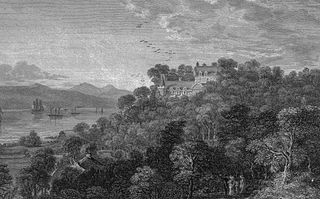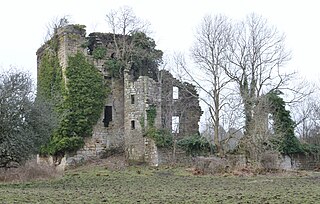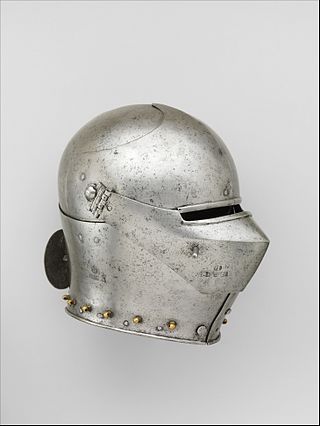
The Brisbane Aisle (NS 220247, 659447) is a small 17th century free-standing burial vault, built for the Shaws of Kelsoland (aka Brisbane) and situated in the grounds of the 'Largs Old Kirk', Largs, Ayrshire, Scotland. [1]

The Brisbane Aisle (NS 220247, 659447) is a small 17th century free-standing burial vault, built for the Shaws of Kelsoland (aka Brisbane) and situated in the grounds of the 'Largs Old Kirk', Largs, Ayrshire, Scotland. [1]
Built for the Shaws of Kelsoland, this category A listed building became the burial vault of the Brisbane family sometime after 1695. The date 1634 as inscribed on a heraldic datestone at the east side of the structure, above a sealed portal. A heraldic panel is inscribed with "P.S" and "I.S", indicating the Shaws of Kelsoland. An armorial device with mullets (stars) for the Shaw and annulets (rings) for the Montgomeries of Braidstone is present. A carved armorial device on the west side carries the initials "P.S./I.M./I.S". [1] [2] Major-General Sir Thomas Makdougall Brisbane, 1st Baronet GCH, GCB, FRS, FRSE (23 July 1773 – 27 January 1860) a British soldier, colonial governor and astronomer, is interred within the aisle.

The aisle is small and rectangular in plan, gabled, with finely squared ashlar masonry, bolection moulding at the wallhead, and cavetto moulded skewputts and apex stones. The east-facing gable carries 19th-century exterior wall-mounted marble memorial panels with block pediments. The striking slab roof is at a lower pitch than the steeply-pitched gable ends, probably as a result of repairs. [1]

The Skelmorlie Aisle stands to the east of the Brisbane Aisle, also a category A listed building and containing a notable monument built by a local landowner, Sir Robert Montgomerie of Skelmorlie Castle, seventh laird of Skelmorlie as a burial site for himself and his wife, Dame Margaret Douglas. [3] The aisle was added to the old kirk (church) of Largs in 1636.
The nearby Skelmorlie Aisle is in the care of Historic Scotland. Admission to the Brisbane Aisle is free; both the kirkyard and museum are open from late May to early September from 2.00pm to 5.00pm.

Skelmorlie is a village in North Ayrshire in the south-west of Scotland. Although it is the northernmost settlement in the council area of North Ayrshire, it is contiguous with Wemyss Bay, which is in Inverclyde. The dividing line is the Kelly Burn, which flows into the Firth of Clyde just south of the Rothesay ferry terminal. Despite their proximity, the two villages have historically been divided, Skelmorlie in Ayrshire and Wemyss Bay in Renfrewshire.

Major General Sir Thomas Makdougall Brisbane, 1st Baronet,, was a British Army officer, administrator, and astronomer. Upon the recommendation of the Duke of Wellington, with whom he had served, he was appointed governor of New South Wales from 1821 to 1825.

Largs is a town on the Firth of Clyde in North Ayrshire, Scotland, about 33 mi (53 km) from Glasgow. The original name means "the slopes" in Scottish Gaelic.

Inverkip is a village and parish in the Inverclyde council area and historic county of Renfrewshire in the west central Lowlands of Scotland, 5 miles (8 km) southwest of Greenock and 8.1 miles (13 km) north of Largs on the A78 trunk road. The village takes its name from the River Kip and is served by Inverkip railway station.

Eglinton Castle was a large Gothic castellated mansion in Kilwinning, North Ayrshire, Scotland.
Annick Lodge is an estate between Perceton and Cunninghamhead in North Ayrshire, Scotland.

The Skelmorlie Aisle of Largs Old Kirk is the remains of a church in the town of Largs, Ayrshire, Scotland.

Durisdeer is a small village in Dumfries and Galloway, south-west Scotland, and in the historic county of Dumfries-shire. It lies 6 miles (9.7 km) north of Thornhill, above the Carron Water, a tributary of the Nith.

Skelmorlie Castle stands on the eastern shore of the Firth of Clyde, Scotland, at the north-western corner of the county of Ayrshire. The structure dates from 1502, and was formerly the seat and stronghold of the Montgomery Clan. The modern village of Skelmorlie lies to the north of the castle.

Polnoon Castle was a 14th-century fortification located on a motte beside the Polnoon Water in Millhall, in the Parish of Eaglesham, East Renfrewshire, Scotland.

Barnweill Church or Barnweil Church is a ruined pre-reformation kirk situated on rising ground on the slopes of Barnweill Hill, Parish of Craigie, South Ayrshire, Scotland; about 3 km from Tarbolton. The church was known locally as the "Kirk in the Wood". It lies about 170m North North-East of Kirkhill Farm. Barnweill was central to the Protestant Reformation in Ayrshire through its association with John Knox. The spelling 'Barnweill' is used throughout for consistency.

The Lands of Pitcon, previously Potconnel now form a small estate of around 100 acres in the Parish of Dalry, North Ayrshire in the old Barony of Dalry. The present category B listed Georgian mansion house dating from 1787, replaces an older castellated dwelling. Pitcon lies on the outskirts of Drakemyres, now a suburb of Dalry, close to the confluence of the Rye Water, River Garnock, and the Mains Burn, standing on a low knoll. Such a marshy area would have provided a degree of protection to the old castle.

The substantial remains of the old castle and sixteenth century manor house of Kilbirnie lie west of the town of Kilbirnie in North Ayrshire, Scotland, on the lower slopes of the Glengarnock Hills, in the old Barony of Kilbirnie. The building is also variously known as the Place of Kilbirnie, The Place, or Kilbirnie House.

The Murder of Hugh Montgomerie, 4th Earl of Eglinton at the Annick Ford in Stewarton, East Ayrshire, Scotland, took place in 1586 as a consequence of a long running feud between the Montgomeries, Earls of Eglinton and the Cunninghames, Earls of Glencairn, families who were competing for power and influence locally and nationally. The significant repercussions of this act were felt throughout the county of Ayrshire and beyond. The spelling 'Montgomerie' is used throughout for both the family and Montgomery for the clan and clan and district names 'Cunninghame' in the same fashion.

Funerary Helmets,Mortuary Helms, or Mort Helms were the major element of a suit of armour that was most often placed above or near the carved memorial effigy of the knights or members of the nobility concerned in a tradition that ran from at least the 14th through to the 17th century, particularly when the person concerned had gained a reputation in life as a warrior. These helmets were often brightly painted or otherwise ornamented with floral designs, etc. Largely located within rural churches and other religious buildings, the practice was especially common in the south-west English counties and Cornwall with only a few examples known from Scotland.

Cullen Old Church is the parish church for Cullen and Deskford, in Moray. It was originally a part of the Roman Catholic Church, but has been a part of the Church of Scotland since the Scottish Reformation. John R. Hume describes Cullen Old Church as a fine example of late Scots Gothic architecture, and it was designated a Category A listed building in 1972. It is still an active place of worship, with weekly services presided over by Rev Douglas F Stevenson.

Lawthorn is a hamlet near Perceton in Strathannick, Irvine, North Ayrshire, Scotland. The settlement lies on the old Irvine to Stewarton toll road.

The Glencairn Aisle or Glencairn Vault at Kilmaurs, East Ayrshire is a Category B Listed vaulted sepulchral chapel built as a place for private contemplation and prayer that also contains a large memorial monument, as well as the burial crypt of the Cunningham Earls of Glencairn and their family members. It houses an exceptional ornately carved stone mural monument dated 1600 that commemorates James Cunningham, the 7th Earl of Glencairn, his countess, Margaret Campbell and eight of their children. It is the oldest such 'Glorious Tomb' monument built in the 17th century in Ayrshire and one of the oldest post-reformation monument in Scotland. The other Ayrshire examples being the Kennedy or Bargany Aisle at Ballantrae of circa 1601, the Skelmorlie Aisle at Largs of 1639, the Crauford Monument at Kilbirnie and the Hamilton Aisle at Dunlop of 1641.

The Kennedy Aisle or Bargany Aisle at Ballantrae, South Ayrshire is a vaulted burial chamber and crypt containing a large mural memorial, the Kennedy Monument, an ornately carved stone monument dated to between 1602 and 1605 that commemorates Gilbert Kennedy of Bargany and Ardstinchar, his wife, Janet or Jean Stewart, who died in 1605 and three of their children.
Notes
Sources